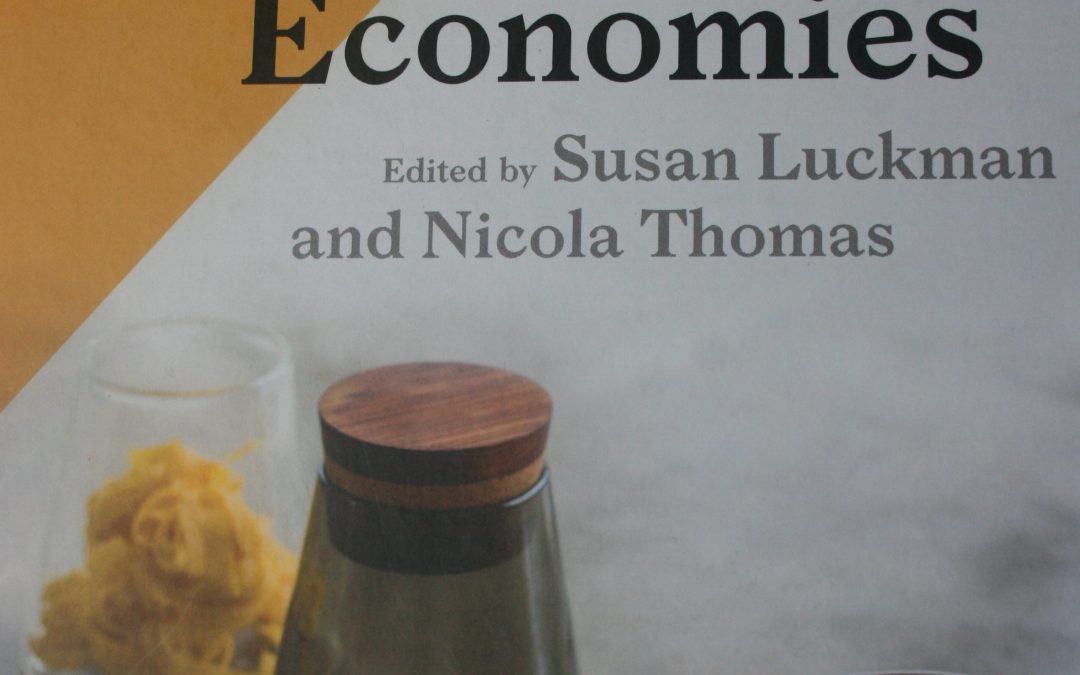Craft Economies Ed Susan Luckman and Nicola Thomas (2018) London & New York: Bloomsbury Academic
‘Comprising a collection of 20 essays from 28 academics, practitioners, Craft Economies spans a wide landscape of craft practices, sites and forms of making from floristry to ceramics and from crochet to coding. It brings into focus such topics as the significance of place, the role of the digital, and conflicts between the homemade and the commodity, and looks at both regional and national contexts, from global distribution to local communities.’ (taken from the back cover but encapsulating the contents perfectly!)
It looks at topics and concepts such as disruptive collaboration, commodity activism and individualized consumption. Quite a lot of the essays didn’t mean much to me, but there are three that resonated with me.
Chapter 7 ‘Dichotomies in textile making: Employing digital technology and retaining authenticity’ – Sonja Andrew and Kandy Diamond
Chapter 9 ‘The ghost potter : Vital forms and spectral marks of skilled craftsmen in contemporary tableware’ Ezra Shales
Chapter 17 ‘Knitting and crochet as experiment: Exploring social and material practices of computation and craft’ Gail Kenning and Jo Law
There has long been a discussion between makers and the public (as well as a certain amount of introspective soul-searching as craft practitioners) as to where, if at all, the boundary can be placed when designing and making art or products (whether textiles or anything else) using digital technology. As a weaver, I have been using digital technology for many years in designing with a weaving software programme which allows me to create my own designs on the software and then to utilise an interface so that the computer can ‘talk’ directly with a solenoid box mounted on the side of my loom in an electronic version of pegs and lags of mechanical looms. In the 1980s there were considerable heated conversations in the hand-weaving community as to whether using computers for designing or assisting with sending instructions to the loom (instead of physically cutting holes in cards or putting pegs into lags) was still classed as ‘handweaving’ despite all the designing being the weaver’s own brainwork, and all the loom set-up and physical weaving (throwing the shuttle, physically lifting shafts with foot pedals or levers) still being performed by the weaver. It was therefore a little like a time-warp to read of the dichotomy that Sonja Andrew (print) and Kandy Diamond (machine knit) were still experiencing about their respective textile practices in 2015/16.
Weaving suits the computational mode as a thread is either up or down, on or off. Jacquard looms (which were effectively the fore-runners of the computer) work on this basis and used punched cards where a hole in the card ‘switched’ a thread ‘on’ (up) and a blank on the card meant ‘off’ (remain down) so it was no surprise that weaving and computers have always had a close working relationship. Having been excited by the wonderful world of Dr Taimina and her Crocheting Adventures with Hyperbolic Planes and then seeing it come into fruition with the Wertheim sisters (Margaret and Christine) through the Hyperbolic Coral Reef, which has now travelled to many countries and continues to grow to be the largest communal project in the world, it was fascinating to read the links between knitting and crochet and computational and digital technologies that Gail Kenning and Jo Law have been exploring in education, combining the physicality of knitting and crochet and the abstraction of coding. The essay encouraged me to consider the relationships of other constructed textiles with weaving, and, even though I don’t have a grasp of higher mathematical concepts, to appreciate the total integration and inter-connectedness of the abstract principles of maths and design, as also embodied in other disciplines, especially 3D printing.
I was also fascinated to read of the ghost potters of Stoke-on-Trent, a place I know very well, having lived in the neighbouring Staffordshire Moorlands for 27 years. The marriage of hand-crafted prototypes and industrial processes also rings true for weavers and weaving. There have been, and will continue to be, many anonymous freelance weave-designers who create the original designs of fabrics that we see in our high-street shops and boutiques, and some who have a higher profile who nevertheless then get their designs woven industrially so that they can be sold to a wider audience. It was ever thus in the world of fabric but it is interesting to see that this model is so rare now in the ceramics industry of Stoke-on-Trent that it is now celebrated in this essay.
I do love a book that will stretch my mind and force me to consider topics from a different approach, and this book has certainly done that. From a research perspective, it gives you a moment-in-time look at the mid 2010s and it could be read in conjunction with recent ecological and consumerism exhibitions as perhaps a signifier for future developments in craft/industrial/digital processes but it remains to be seen whether some of the essays will be seen as truly prophetic in their approach, or destined to be a philosophical cul de sac.

